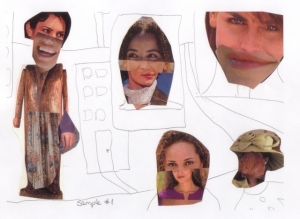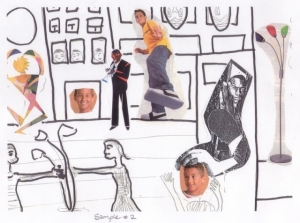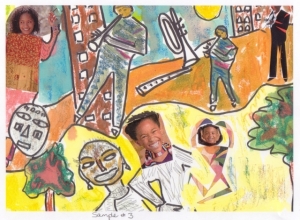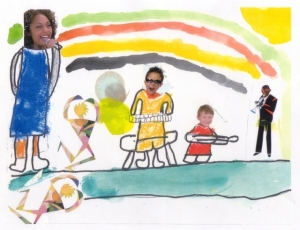 |
Lesson
Plan: Bearden
Art-Making Workshop
Art Aware
1701 South 4th Street
Camden, NJ 08014
(856) 365-0831
artaware@hotmail.com
|
Click
on any image for black & white version.
Objective:
The students will be able to create their own collages using some
of the same kinds of images and materials Bearden used.
Skills: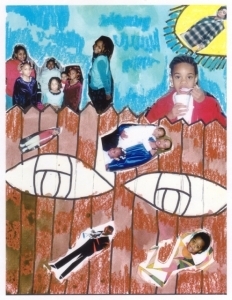
Students will put to use some of the Bearden techniques they observed
in the reproduction/slide lecture and learn to spontaneously add their
own painted and graphite images to create their own unique artwork.
They will learn the visual difference in smaller colored artwork and
enlarged black/white copies (cf. Bearden’s Photostats).
Materials:
-
8&1/2”x11” white watercolor paper
-
Cut-out images prepared by students and/or teacher: of people (include
body parts, small and large images), places (urban and rural), things
(buildings, objects-animate and inanimate) from photos, ads, magazines,
newspapers, etc.
-
Watercolor sets (where water is put into top of case so colors mix
thus making it more difficult for students to be “perfectionists”
wanting pure colors that don’t bleed together! Bearden loved
the “bleeding.”)
-
scissors
-
glue sticks
-
pencils with erasers
-
permanent black markers
-
11”x17” paper for enlargements of student work
-
copy machine with enlargement feature
-
cassette/CD player
-
cassette/CD of jazz music (see Resource
list #5)
Procedure:
Jazz music will be played softly during workshop.
First,
be sure to do your own sample. Show your stages to show students what
they should be aiming for!
|
Stage
1) cut-outs and pastings, pencil drawings |
Stage
2) black marker over some pencil drawings |
|
|
Stage
3) water coloring
|
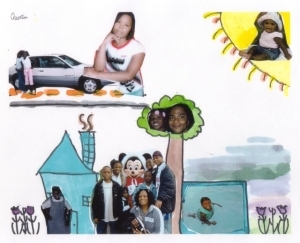 Students
will choose and cut out images/textures they like and glue them on
the white watercolor paper leaving white spaces for symbolizing “riffs”
in jazz and for doing their own individual pencil images and water
coloring. Students
will choose and cut out images/textures they like and glue them on
the white watercolor paper leaving white spaces for symbolizing “riffs”
in jazz and for doing their own individual pencil images and water
coloring.
Encourage
students to cut faces and bodies up, as Bearden did, to come up with
composite people (white/black, African/European, etc.)
After
enlarging each student’s work on copy machine onto 11”x17”
paper, teacher will mount it next to student’s original color
work and discuss how the colored juxtapositions of cut-outs create
images that tell stories. Those same
images in black and white often tell different stories which are
sometimes more objective and journalistic.
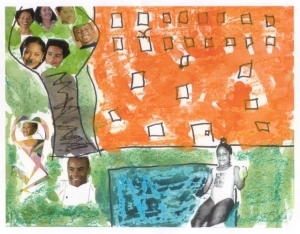 Mount
all the students’ colored and black/white images together with
a copy of Bearden’s colored “The
Street” and his black/white enlarged Photostat
of “The Street” together with a written description
so that all passersby can appreciate Bearden’s (and the students’)
intentions. Mount
all the students’ colored and black/white images together with
a copy of Bearden’s colored “The
Street” and his black/white enlarged Photostat
of “The Street” together with a written description
so that all passersby can appreciate Bearden’s (and the students’)
intentions.
To make
it last the whole year (there will be enough variety to make it interesting
to look at for the whole year), mount the artwork in 22’ panels
and laminate and hang in school with Velcro strips.
Evaluation:
Students will discuss their displayed colored and enlarged black/white
artwork with teachers, friends, visitors, etc.
Written
Description of Exhibition:
Student
Exhibition
At
XYZ School
Art Teacher’s name
Romare
Bearden was one of the most outstanding artists of the 20th century.
He brought
the whole world together with his art.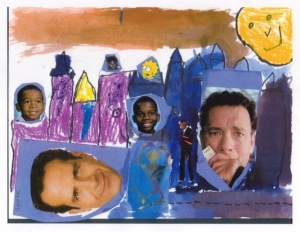
He especially
highlighted the universality of his African-American heritage.
In 1964,
Bearden experimented with black and white Photostat enlargements of
his art work. (See the two examples of “The Street.”)
He was
aiming for an objective, journalistic expression in the enlargements.
In his color collages there are often more clashes between the elements.
In his black/white Photostats there are sometimes less differences
between the collage pieces.
In this
exhibition, enjoy the differences!
Copyright
© 2005 Art Aware.
Return
to Romare Bearden.
Go to Art Aware.
Updated
November 20, 2013
http://www.artaware.org/artmakinglessonplan.htm |


